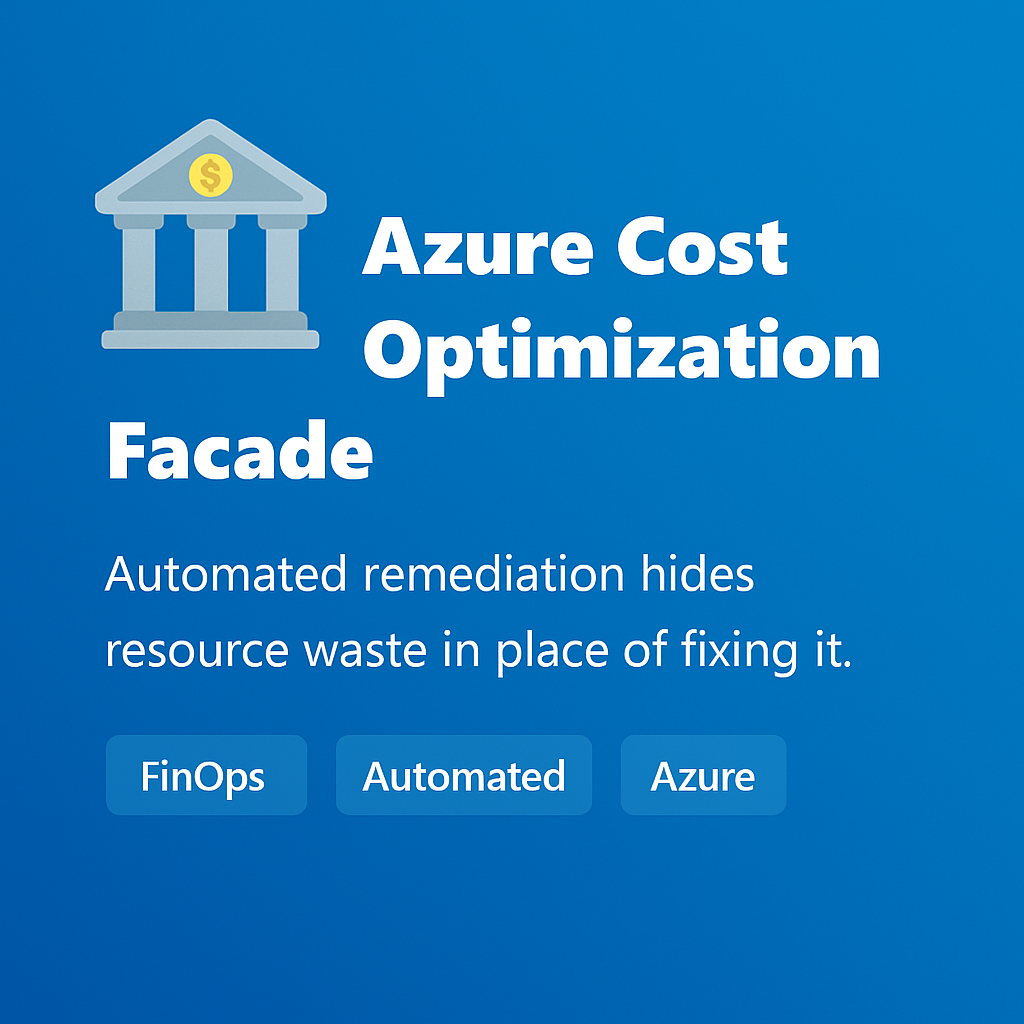
The Azure Cost Optimization Facade
2025-11-03 · ~4 min read
Most Azure optimization advice is surface-level. Reserved instances aren’t FinOps. Here’s what meaningful cost reduction really takes.
This guide is part of our Azure FinOps hub covering cost management, chargeback models, and financial operations at enterprise scale.
Your CFO just forwarded you another email: "Azure Advisor says we can save $47,000/month. Why haven't we acted on this?"
You know the truth. Those recommendations are garbage.
The Azure Advisor Lie
Microsoft's cost optimization tool promises savings. What it actually delivers:
- "Right-size this VM" → Recommends downsizing your production SQL server during month-end close
- "Delete this unused disk" → Points to your disaster recovery snapshots
- "Buy a reservation" → For workloads you're migrating off next quarter
Azure Advisor doesn't understand your business. It sees cloud resources—not the applications, SLAs, and political realities behind them.
And here's the real kicker: Microsoft doesn't care if you action these recommendations. They're not measured on your cost savings. They're measured on Azure consumption growth.
Why Cost Optimization Fails (The Real Reasons)
1. No Context, No Value
Azure Advisor has zero visibility into:
- Your maintenance windows
- Application dependencies
- Business criticality
- That upcoming migration everyone knows about
Result? Recommendations that look good in PowerPoint but break production when implemented.
2. Metrics That Don't Matter
- CPU utilization over 7 days? Meaningless for batch workloads
- "Idle" VMs? That's your DR environment, genius
- Storage not accessed in 90 days? Meet compliance retention
3. The Accountability Gap
Who gets blamed when "right-sizing" kills performance?
You do.
Who gets credit when you save money?
Finance does.
Who faces zero consequences for bad recommendations?
Azure Advisor.
What Actually Works (No BS)
Here's the harsh reality from someone who's actually reduced Azure spend:
Start With Apps, Not Resources
Don't ask "Can we downsize this VM?"
Ask "Does this application still deliver business value?"
The biggest savings come from killing zombie applications—not optimizing them.
Tag Everything (No, Really)
Without tags, you're flying blind:
Environment: Production
CostCenter: Finance
Owner: jane.smith@company.com
AppID: SAP-ERP-PROD
EOL: 2026-Q4
Tags enable the one thing Azure Advisor can't: Human judgment.
Build Your Own Optimization Logic
Azure Advisor is one-size-fits-all. You need business-context-aware logic:
Resources
| where type == "microsoft.compute/virtualmachines"
| where tags.Environment == "Production"
| where tags.EOL < now()
| where properties.hardwareProfile.vmSize startswith "Standard_D"
| project name, resourceGroup, vmSize, tags.Owner, tags.EOL
This finds oversized VMs in your context—not Microsoft's guesses.
Focus on the Big Three
- Zombie resources (running but unused)
- Orphaned disks (the real ones, not DR)
- Dev/test overprovisioning (nobody needs a Standard_D16 for testing)
Skip the rest. Seriously.
The Uncomfortable Truth
Real cost optimization requires saying "no."
- No to that legacy app nobody uses
- No to "temporary" dev environments running 24/7
- No to over-architecting for scale you'll never hit
Azure Advisor can't say no. It can only recommend incremental tweaks while your actual waste is architectural.
What to Do Tomorrow
-
Stop treating Advisor recommendations as gospel
→ They're suggestions, not commandments -
Tag your resources by business owner
→ Make cost conversations direct, not theoretical -
Query by business context, not cloud metrics
→ "What's Finance spending on VMs?" > "What VMs are underutilized?" -
Kill one zombie app per quarter
→ This will save more than a year of "right-sizing"
Azure cost optimization isn't about following Microsoft's checklist. It's about understanding your own business well enough to make ruthless decisions.
Azure Advisor is a starting point—not a strategy.
Reality Check: Want to see what meaningful cost reduction looks like? Check out my Complete Guide to Azure Cost Optimization where I walk through the actual process—tags, KQL queries, accountability models, and the conversations with Finance that actually work.
No fluff. Just the blueprint I've used to cut real Azure spend without breaking production.
Azure Admin Starter Kit (Free Download)
Get my KQL cheat sheet, 50 Windows + 50 Linux commands, and an Azure RACI template in one free bundle.
Get the Starter Kit →Get more Azure content like this
Join Azure pros getting practical KQL queries, cost optimization tips, and real-world solutions delivered weekly.
💰 Stop Guessing at Azure Costs
Get the Azure FinOps Framework with cost allocation templates, tag governance policies, and showback dashboards that finance actually understands.
Download FinOps FrameworkExcel template • KQL queries included • No email required
